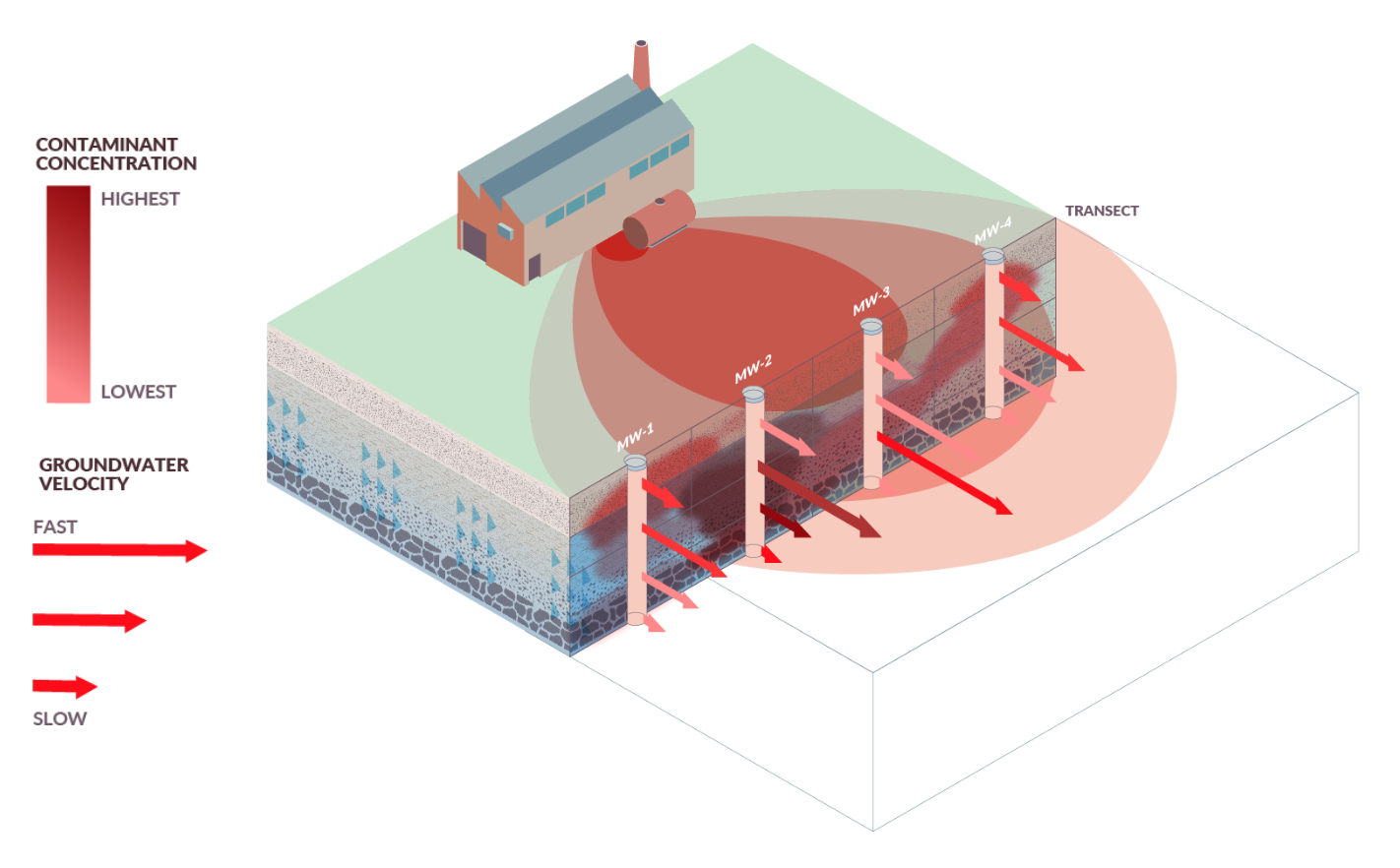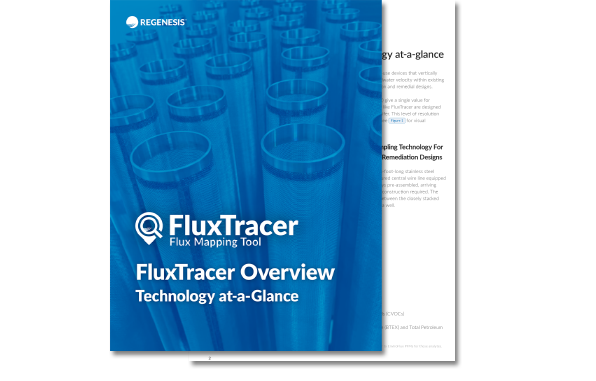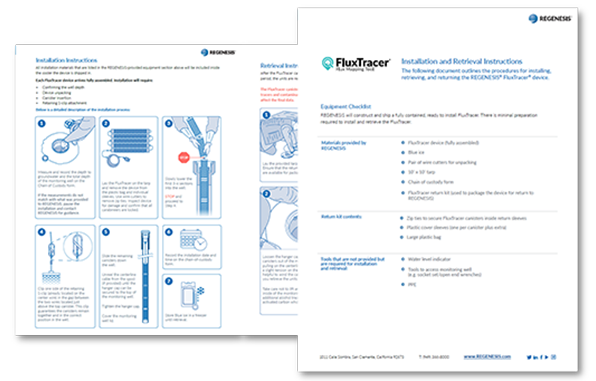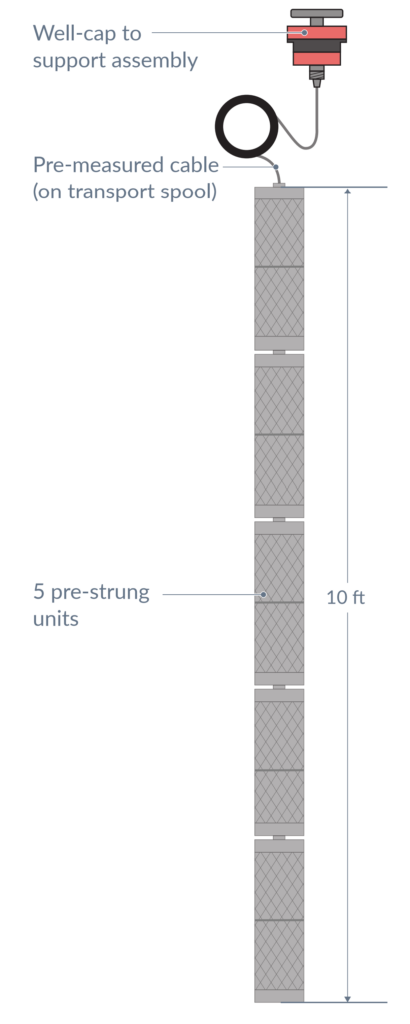
FluxTracer: Technology at-a-glance
FluxTracer® Flux Mapping Tools are easy-to-use devices that vertically delineate contaminant mass flux and groundwater velocity within existing monitoring wells to aid in site characterization and remedial designs.
Conventional methods (pump and slug tests) give a single value for groundwater velocity whereas passive tools like FluxTracer are designed to distinguish individual zones within an aquifer. This level of resolution is especially useful for remediation design.
A Dual-Functioning, Passive Sampling Technology For Site Characterization and In Situ Remediation Designs
The FluxTracer consists of separate two-foot-long stainless steel cannisters internally spaced in two chambers and secured in a series on a premeasured central wire line equipped with a modified J-plug. FluxTracers are always pre-assembled, and ready to deploy with no onsite construction required. The unique design provides joint-like flexibility between the closely stacked cannisters to easily install and remove from a well.
Key Benefits:
- High Data Resolution and Accuracy
- Plume Characterization
- Estimate In Situ Product Longevity
- Reliable Turnaround Time
- Affordable with Full Customer Support
Fast Installation:
- 15-Minute Install Per Device
- Ready to Deploy Upon Arrival
- No Assembly Required
Target Contaminants:
- Chlorinated Volatile Organic Compounds (CVOCs)
PFAS - Benzene, Toluene, Ethylbenzene, Xylene (BTEX) and Total Petroleum
- Hydrocarbons (TPH)*
* Analysis for BTEX and TPH are in development.
What is Mass Flux?
Mass flux is defined as the contaminant mass moving across a unit area (aquifer) perpendicular to the groundwater flow direction. Mass flux is measured as mass/area/time.
How To Order
Step 1
Step 2
Contact Us
Reach out to us to review the evaluation form and define the site needs and FluxTracer best practices
Talk to an ExpertStep 3
Place Order
The number and type of devices requested will be prepared and shipped
Step 4
Deployment
Receive FluxTracer device(s) on-site ready to deploy. After deployment, retrieve devices, store in return kit and ship back for analysis
Step 5
Analysis and Reporting
Once the Fluxtracer(s) are received and analyzed, a report with the darcy velocity and mass flux of contaminants will be generated
How FluxTracer Works
Each FluxTracer canister is filled with an adsorbent material pre-loaded with biodegradable tracers. The tracers are composed of five different alcohols each having well-known partitioning characteristics with the media. As groundwater passively flows through a FluxTracer canister over the deployment period, the alcohol tracers are depleted from the adsorbent material, with the net loss of the tracers directly correlating to the groundwater speed. At the same time, the contaminants of concern (COC) present in the groundwater adsorb to the FluxTracer during the deployment period. The total mass of contaminants accumulated on the adsorbent material is then quantified and the contaminant mass flux is calculated.

Oftentimes 90% of contaminant mass is moving through 10% of the aquifier
Figure 1: Measuring Groundwater Velocity & Mass Flux: Data Comparison
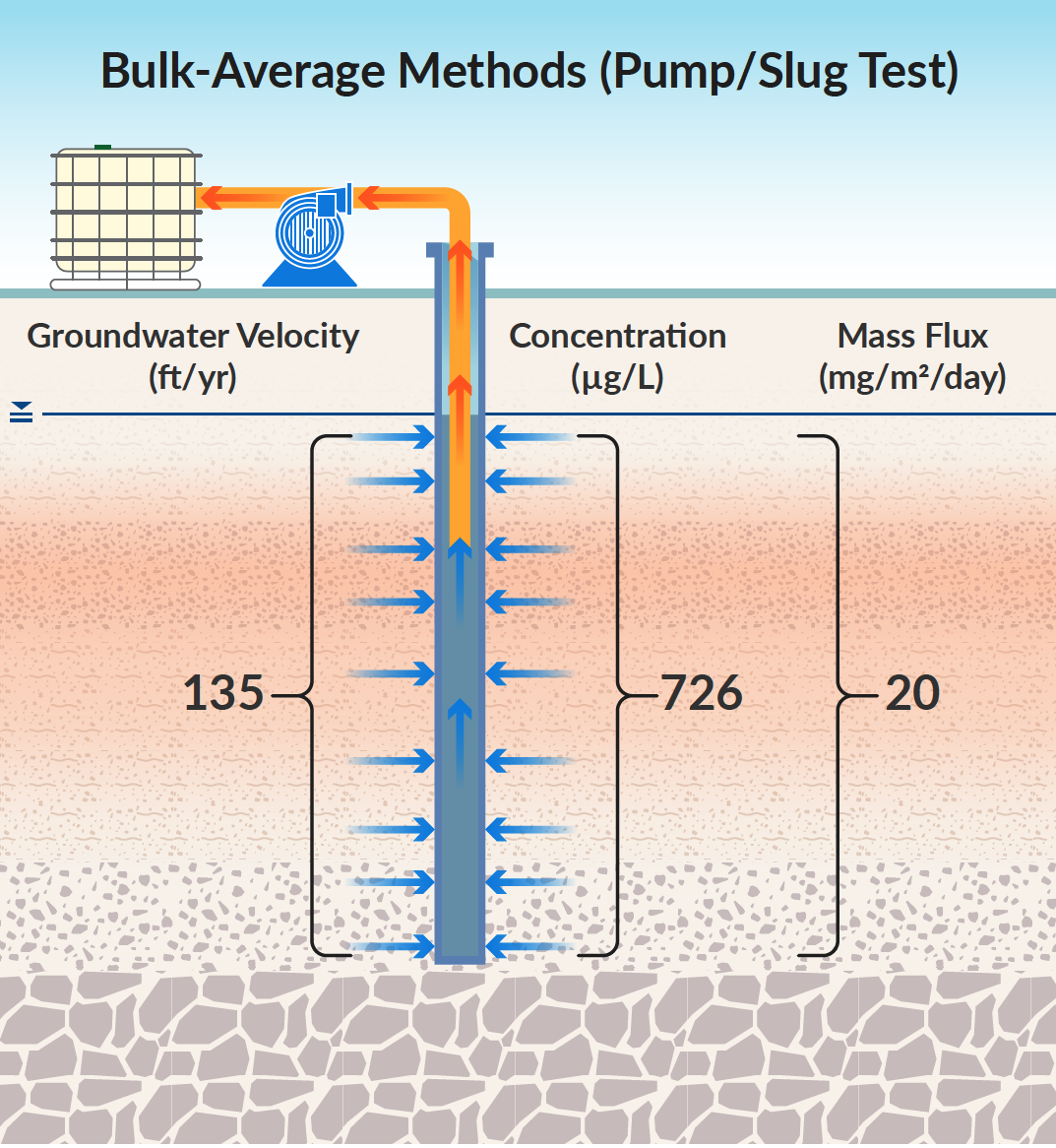
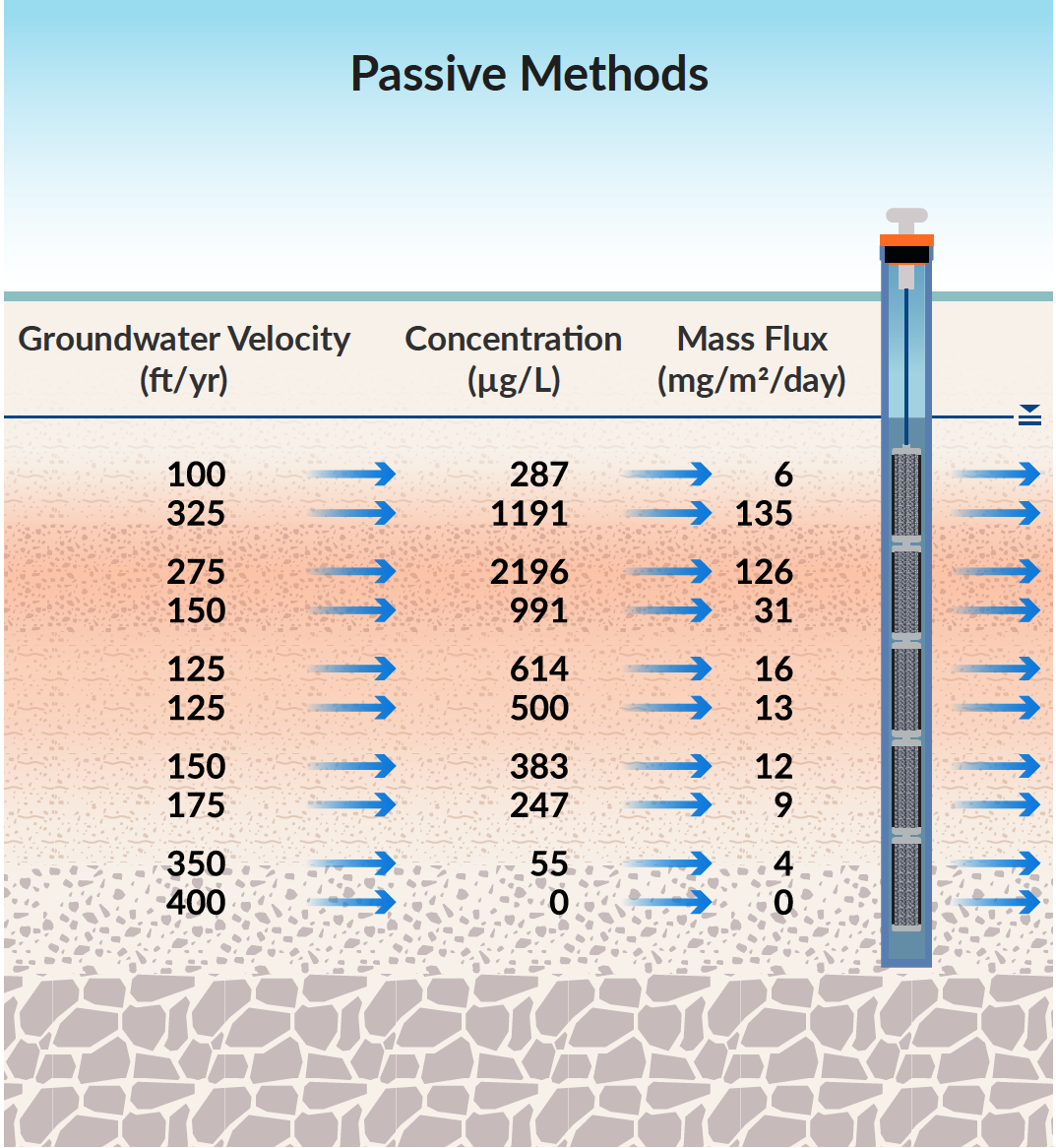
Figure 2: Conceptual Site Model
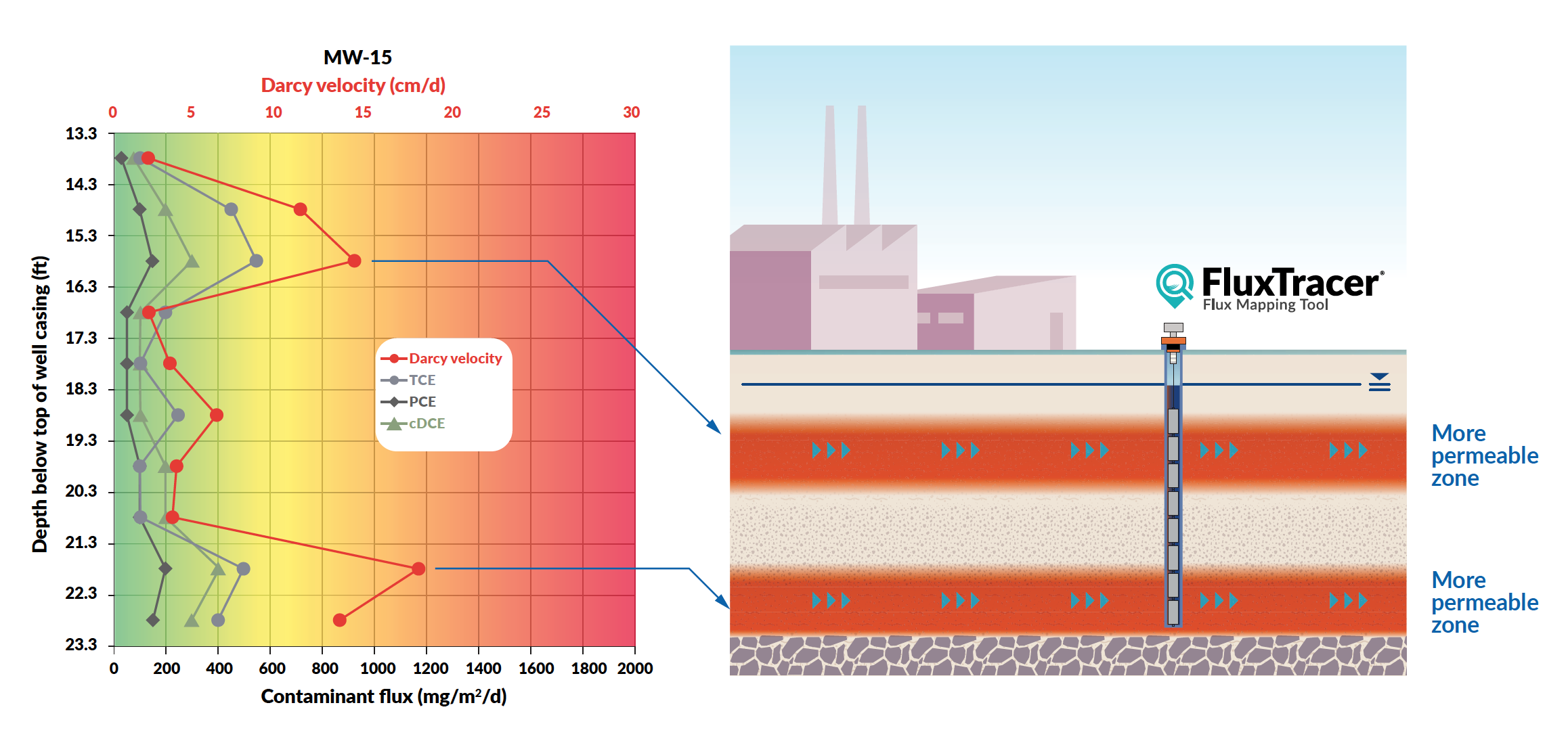
Frequently Asked FluxTracer Questions
What is mass flux?
Mass flux refers to the rate at which contaminants move across an aquifer perpendicular to the direction of groundwater flow. It is measured as mass/area/time (e.g., mg/m2/day). Understanding mass flux is essential as it helps quantify the actual movement of contaminants.
Why design remediation efforts based on mass flux rather than concentration alone?
Concentration alone does not provide information about the amount (mass) of contaminant moving into a treatment area. FluxTracer plays a pivotal role in precisely delineating impacted zones, estimating the longevity of remediation products, and devising more effective and targeted remediation strategies.
Can FluxTracer data assist in regulatory compliance and stakeholder communication?
Yes, understanding mass flux through FluxTracer data provides robust scientific evidence that can support regulatory compliance efforts. Nonetheless, the reports are not intended for regulatory purposes but to provide clear insights into contaminant movement and enhance stakeholder communication by providing transparent and actionable information about the remediation process.
What contaminants can FluxTracer measure?
FluxTracer can measure Chlorinated Volatile Organic Compounds (CVOCs) and PFAS. Research is ongoing to add BTEX compounds to the list starting in 2025. The CVOCs species FluxTracer can detect are PCE, TCE, and cis-DCE. For PFAS, the 40 analytes listed in EPA Method 1633 are reported.
How is the depth-dependent concentration of contaminants calculated in the reports?
Flux derived concentration ![]() is derived from field measurement of mass flux and Darcy velocity as follows:
is derived from field measurement of mass flux and Darcy velocity as follows:
![]()
What is the reporting limit of Darcy velocity and mass flux of FluxTracers?
Groundwater velocities below 2 cm/day are not accurately distinguishable and, therefore, reported as <2 cm/day. The mass flux reporting limit for CVOCs is around 1 mg/m2/day, and for PFAS, it is 0.5 μg/m2/day.
Can FluxTracer measure groundwater flow direction?
No, FluxTracer devices are explicitly designed to quantify contaminant mass flux and groundwater speed within monitoring wells. Determining groundwater flow direction requires additional site-specific information and traditional groundwater level/elevation data analysis by qualified environmental professionals. For precise flow direction determination, engineers integrate mass flux data with other site-specific hydrogeological information and tools to assess groundwater dynamics comprehensively.
What are the requirements for monitoring wells to deploy FluxTracers?
The monitoring wells must be built in 2-inch schedule 40 and must accurately represent the section of the aquifer studied.
Can FluxTracer be applied to sites where only Darcy velocity is required?
Yes, we offer FluxTracers for sites where only Darcy velocity measurements are needed.
What is the required deployment time for the FluxTracers? Would longer deployment times yield more accurate results?
FluxTracers are typically deployed for a two-week period, although the actual time is determined on a case-by-case basis. While longer deployment times can increase the sensitivity of FluxTracers in low mass flux scenarios, they can also result in potential washout of the tracers in aquifers with fast groundwater velocity or where tracers are easily susceptible to degradation (e.g., sites where biostimulation or bioaugmentation occurred).
Can I request FluxTracer services without Buying Regenesis products?
Yes, FluxTracer services are currently available to the public.
What is the expected turnaround time from receipt of the devices from the field and issuance of a report?
The typical turnaround time for up to 5 devices is three weeks; for more than five units, it will vary depending on the number of devices deployed.
How long does the installation of FluxTracer take?
Installing FluxTracers is quick and easy, typically requiring only about 15 minutes per device. FluxTracers are delivered pre-assembled and ready for immediate deployment upon arrival. This streamlined approach eliminates on-site assembly requirements, ensuring a hassle-free setup process.

 Americas
Americas Europe
Europe Français
Français Deutsch
Deutsch Italiano
Italiano Español
Español
